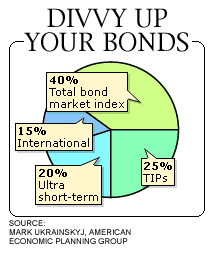NEW YORK (CNN/Money) -
Amid continued concern that interest rates may soon rise along with inflation, bond prices took another big hit on Tuesday.
The price on the 10-year Treasury fell sharply, pushing the yield to its highest level in nearly a year.
Higher yields are great for the income. But if you buy in a rising rate environment you stand to lose money if you sell before a bond matures. And if you've owned a bond fund for awhile, the share price could take a hit, eating into the profits you made during the bear market, when bonds were the only investment showing you any love.
So take the recent slide in bond prices as a big wake-up call to rebalance your portfolio, which may have gotten out of whack during the bond rally of the past few years.
Certified financial planner Tom Grzymala generally recommends investors under 45 have a 70-30 mix of stocks to bonds; investors between 45 and 55 have a 65-35 mix; and investors over 55 have a 60-40 mix. (For help figuring out the right mix for you given your age and risk tolerance, try our Asset Allocator.)
Think short-term
Next, think about the specific fixed-income investments in your portfolio. If interest rates rise, bond prices will fall -- but not all bonds will fall the same amount.
| More on Bonds
|

|
|
|
|
The longer the duration of a bond (or the average duration of a bond fund), the bigger the hit when rates rise.
Here's a way to estimate just how much. For every percentage point interest rates rise, a bond's resale value declines by a percentage equal to the duration.
Say rates rise one percentage point. If you've invested in the Vanguard Long-Term Bond Index, which has an average duration of 10.92 years, the net asset value of that fund stands to lose 10.92 percent.
There's less risk in investing in the Vanguard Intermediate-Term Bond Index, with an average duration of 5.99 years -- its NAV stands to lose 5.99 percent. And the Vanguard Short-Term Index, with an average duration of 2.37 years, carries the least risk of the three. (Check the average duration of your bond fund on CNN/Money's Morningstar Snapshot Report -- it's on the "portfolio" page.)
Grzymala recommends substantially reducing your exposure to long-term bonds and moving the money into intermediate- or short-term funds.
Owners of individual bonds may not care so much about the interest rate game. "If you hold the bond to maturity, price fluctuations aren't relevant," said Morningstar senior fund analyst Bradley Sweeney. That's because you will recoup your principal or the bond's face value at maturity (assuming the bond issuer does not default) and in the meantime you can enjoy the income.
Think diversity
While financial advisers recommend that your new bond money go into bonds with shorter durations, they also want their clients' long-term money diversified across many asset classes in the fixed-income market.

"The whole bond market isn't monolithic...There's the Treasury market, but that acts very differently than the high-yield market," said Mark Ukrainskyj, senior portfolio manager at the American Economic Planning Group.
But broadly speaking, for investors with a very moderate risk tolerance who don't rebalance more than once a year and who don't consult a financial adviser, Ukrainskyj recommends the fixed-income portion of their portfolio be broken down as follows:
- 40 percent in a total bond market index fund
- 25 percent in a TIPs fund (Treasury Inflation-Protected Securities)
- 20 percent in a stable value or ultra-short-term bond fund
- 15 percent in an international bond fund
More aggressive investors can reduce their allocations in a total bond market fund and TIPs fund and allocate 25 to 30 percent of their fixed income money to a high-yield bond fund and a convertible bond fund.
What about munis?
Municipal bonds or bond funds can be a useful part of a laddered bond portfolio in a taxable account, especially for investors in a high tax bracket and in high tax states. That's because the interest earned is tax-free at the federal level. And if you invest in a muni bond of your state or city, the interest may be tax-free at your state and local level as well.
But if you don't think you'll hold an individual muni to maturity or you don't want to tie your fortunes to the fiscal fortunes of one area, you might be better off in a muni bond fund, Ukrainskyj said.
One that Grzymala likes is the Thornburg Limited Term Municipal Bond Fund.

|

